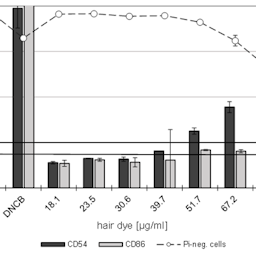Extending the applicability domain of the human cell line activation test (h-CLAT)
Main Article Content
Abstract
Cosmetic ingredients must be toxicologically assessed to determine their skin sensitizing potential. The in vitro human cell line activation test (h-CLAT; OECD TG 442E) addresses the activation of dermal dendritic cells by analyzing specific protein expression after exposure of THP-1 cells to the test chemical. According to the protocol, FITC-labeled antibodies are used for protein detection. However, some chemicals show strong autofluorescence at FITC-specific wavelengths so that antibody-specific signals cannot be distinguished appropriately from autofluorescence background. This leads to inconclusive or false-negative predictions. Alternative fluorochromes can be used if their equivalence with the FITC-labeled antibodies is proven. In the current paper we describe the results of a proficiency exercise, based on the proficiency chemicals listed in the guideline, with FITC-labeled antibodies as the benchmark and APC-labeled antibodies as an alternative detection system. APC emits fluorescence at longer wavelengths, thus avoiding interference in the FITC spectrum. Irrespective of the employed fluorochrome, all chemicals were classified correctly, and the EC150 and 200 values were in the same order of magnitude. Hence, the equivalence in performance of FITC- and APC-labeled antibodies was demonstrated, and the respective demand of the guideline was fulfilled. In a case study, we then tested a proprietary oxidative hair dye using both fluorochromes. Using APC-labeled antibodies, the hair dye was unambiguously identified as a sensitizer, whereas no classification could be made with the FITC-labeled antibodies. With APC, fluorescence interference can be circumvented and the applicability domain of the h-CLAT extended to include autofluorescent chemicals.
Article Details

This work is licensed under a Creative Commons Attribution 4.0 International License.
Articles are distributed under the terms of the Creative Commons Attribution 4.0 International license (http://creativecommons.org/licenses/by/4.0/), which permits unrestricted use, distribution and reproduction in any medium, provided the original work is appropriately cited (CC-BY). Copyright on any article in ALTEX is retained by the author(s).
Basketter, D. A., Alépée, N., Ashikaga, T. et al. (2014). Categorization of chemicals according to their relative human skin sensitizing potency. Dermatitis 25, 11-21. doi:10.1097/DER.0000000000000003
DB-ALM (2014). Protocol No. 158: Human Cell Line Activation Test (h-CLAT). https://bit.ly/35ThGVS
Diepgen, T. L., Ofenloch, R. F. and Bruze, M. (2016). Prevalence of contact allergy in the general population in different European regions. Br J Dermatol 174, 319-329. doi:10.1111/bjd.14167
EC EURL ECVAM (2012). Human Cell Line Activation Test (h-CLAT) Validation Study Report. https://eurl-ecvam.jrc.ec.europa.eu/eurl-ecvam-recommendations
Edwards, A., Roscoe, L., Longmore, C. et al. (2018). Adaptation of the human cell line activation test (h-CLAT) to animal-product-free conditions. ALTEX 35, 477-488. doi:10.14573/altex.1710051
Emter, R. and Natsch, A. (2015). A fast resazurin-based live viability assay is equivalent to the MTT-test in the KeratinoSens assay. Toxicol In Vitro 29, 688-693. doi:10.1016/j.tiv.2015.02.003
EU – European Union (2009). Regulation (EC) No 1223/2009 of the European Parliament and of the Council of 30 November 2009 on cosmetic products (2019). https://eur-lex.europa.eu/legal-content/EN/TXT/PDF/?uri=CELEX:02009R1223-20191127&from=EN
Hoffmann, S., Kleinstreuer, N., Alépée, N. et al. (2018). Non-animal methods to predict skin sensitization (I): The Cosmetics Europe database. Crit Rev Toxicol 48, 344-358. doi:10.1080/10408444.2018.1429385
Kleinstreuer, N. C., Hoffmann, S., Alépée, N. et al. (2018). Non-animal methods to predict skin sensitization (II): An assessment of defined approaches. Crit Rev Toxicol 48, 359-374. doi:10.1080/10408444.2018.1429386
Kosaka, N., Okamoto, K., Miziuno, M. et al. (2008). A study of the criteria for selection of THP-1 cells in the human cell line activation test (h-CLAT): Results of the 2nd Japanese inter-laboratory study. AATEX 13, 33-62. http://www.asas.or.jp/jsaae_old/aatex/13-2-2.pdf
Kreiling, R., Gehrke, H., Broschard, T. H. et al. (2017). In chemico, in vitro and in vivo comparison of the skin sensitizing potential of eight unsaturated and one saturated lipid compounds. Regul Toxicol Pharmacol 90, 262-276. doi:10.1016/j.yrtph.2017.09.023
Langen, U., Schmitz, R. and Steppuhn, H. (2013). Prevalence of allergic diseases in Germany: Results of the German health interview and examination survey for adults (DEGS1). Bundesgesundheitsblatt Gesundheitsforschung Gesundheitsschutz 56, 698-706 [Article in German]. doi:10.1007/s00103-012-1652-7
Nukada, Y., Ashikaga, T., Miyazawa, M. et al. (2012). Prediction of skin sensitization potency of chemicals by human cell line activation test (h-CLAT) and an attempt at classifying skin sensitization potency. Toxicol In Vitro 26, 1150-1160. doi:10.1016/j.tiv.2012.07.001
OECD (2014). The Adverse Outcome Pathway for Skin Sensitisation Initiated by Covalent Binding to Proteins. OECD Series on Testing and Assessment, No. 168. OECD Publishing, Paris. doi:10.1787/9789264221444-en
OECD (2018). Test No. 442E: In Vitro Skin Sensitisation: In Vitro Skin Sensitisation assays addressing the Key Event on activation of dendritic cells on the Adverse Outcome Pathway for Skin Sensitisation. OECD Guidelines for the Testing of Chemicals, Section 4. OECD Publishing, Paris. doi:10.1787/9789264264359-en
OECD (2019). Draft OECD guideline defined approaches for skin sensitisation. https://www.oecd.org/env/ehs/testing/GL%20DASS_22Sep2019v2.pdf
Okamoto, K., Kato, Y., Kosaka, N. et al. (2010). The Japanese ring study of a human cell line activation test (h-CLAT) for predicting skin sensitization potential (6th report): A study for evaluation oxidative hair dye sensitization potential using the h-CLAT. AATEX 15, 81-88. https://www.jstage.jst.go.jp/article/aatex/15/2/15_2_81/_pdf
Peiser, M., Tralau, T., Heidler, J. et al. (2012). Allergic contact dermatitis: Epidemiology, molecular mechanisms, in vitro methods and regulatory aspects. Current knowledge assembled at an international workshop at BfR, Germany. Cell Mol Life Sci 69, 763-781. doi:10.1007/s00018-011-0846-8
Sakaguchi, H., Ryan, C., Ovigne, J. M. et al. (2010). Predicting skin sensitization potential and inter-laboratory reproducibility of a human cell line activation test (h-CLAT) in the European cosmetics association (COLIPA) ring trials. Toxicol In Vitro 24, 1810-1820. doi:10.1016/j.tiv.2010.05.012
Takenouchi, O., Miyazawa, M., Saito, K. et al. (2013). Predictive performance of the human cell line activation test (h-CLAT) for lipophilic chemicals with high octanol-water partition coefficients. J Toxicol Sci 38, 599-609. doi:10.2131/jts.38.599
Verstraelen, S., Maglennon, G., Hollanders, K. et al. (2017). CON4EI: Bovine corneal opacity and permeability (BCOP) test for hazard identification and labelling of eye irritating chemicals. Toxicol In Vitro 44, 122-133. doi:10.1016/j.tiv.2017.06.028


